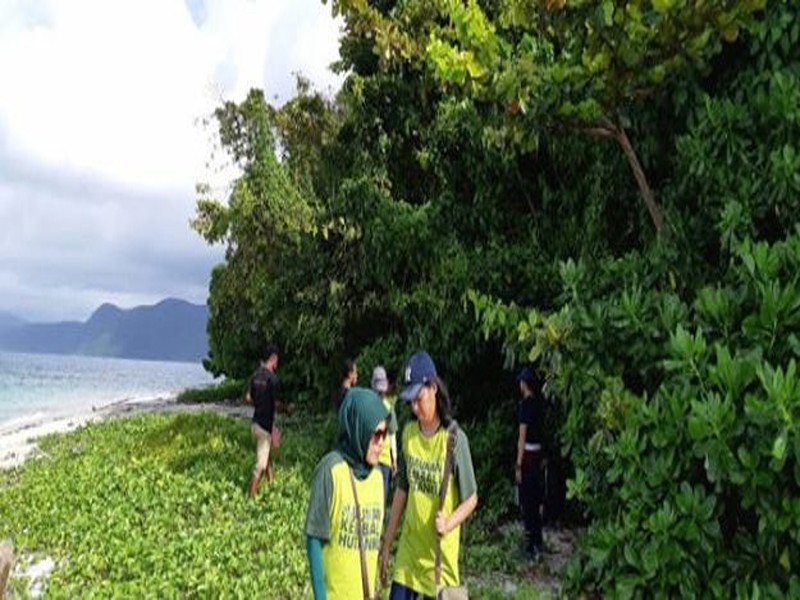Katang Katang Plants A Threat To Leatherback Turtles

The occurrence of leatherback turtles, classified as endangered by the IUCN, is further exacerbated by this situation
-
Date:
09 Apr 2019 -
Author:
KEHATI
Fitri Pakiding, a turtle researcher from Papua State University, recently brought attention to a new concern regarding turtle reproduction. The katang-katang plant (Ipomoea pes caprae), typically found thriving on beaches, has emerged as a potential threat. This alarming information was shared by Pakiding during a presentation in Manokwari, West Papua, on Monday (1/4/2019).
The 2014 recipient of the Whitley Fund for Nature award shared his findings on the connection between a particular plant species and the survival of turtle eggs on Jeen Womom Beach, situated on the northern coast of Tambrauw Regency in West Papua. The investigation focused specifically on the nesting grounds of leatherback turtles (Dermochelys coriaceadi), known as the largest turtle species, and their association with the roots of a specific plant.
The frogs submerge into the sand depths to reach the nest where the turtle lays its eggs. Consequently, the nutrients within the turtle eggs gradually deplete as the roots of the katang-katang (Ipomoea sp) absorb them until the eggs desiccate.
The occurrence of leatherback turtles, classified as endangered by the IUCN, is further exacerbated by this situation. These distinctively dark turtles nest in the Jeen Womom Coastal Park, encompassing the coastal regions of Jamursba Medi (Jeen Yessa) and Warmon (Jeen Syuab) in Indonesia. Out of all the beaches, this particular location remains the sole regular destination for leatherback turtles to lay their eggs. Found commonly in tropical beaches, including Indonesia, the Katang-katang species of beach plant thrives. In Tambrauw, specifically, the local subspecies of katang-katang is identified as Ipomoea pes-caprae spp or coastal batatas, a term used by the local community due to its resemblance to sweet potatoes.
In late 2016, the detection of the katang-katang threat emerged during a turtle survey conducted by the Papua State University Research and Community Service Institute (LPPM Unipa) at Jeen Womom beach. Fitri highlights that the danger lies in these malicious roots penetrating the sand and intruding the turtles’ nests, ultimately endangering the entire cluster of eggs.
“The absorption of all nutrients from the egg by the roots continues until they ultimately desiccate,” he said during a Monday press release.
The aforementioned statement was made during the annual meeting of the Bird’s Head Seascape (BHS) Program in Manokwari, West Papua. This gathering involved various environmental NGOs that are actively participating in the BHS project, namely CI Indonesia, WWF Indonesia, The Nature Conservancy (TNC), Rare, Starling Foundation, and KEHATI Foundation.
A researcher named Dessy Lontoh, affiliated with LPPM Unipa, shared valuable insights during the meeting. As part of her routine duties, she collects and meticulously analyzes data on leatherback turtles in Tambrauw. Ms. Lontoh emphasized that the coastal boundary presents a grave new concern as it has led to the failure of almost all turtle nests to hatch during a particular nesting season. This alarming trend poses a significant threat to the survival of these endangered creatures.
According to Dessy, a mere 1 percent of nests manage to hatch successfully, while the majority fail due to the presence of the batatas plant. In a recent survey, Dessy’s team discovered 500 turtle nests, yet the overwhelming majority failed to hatch as they were covered.
In 2018, only 200 nests out of 350 could be rescued through relocation, while the rest were either washed away by waves or tangled in batatas. Dessy highlights the natural dynamics of the beach, specifically the periodic rise in sea water and the occurrence of large waves, as the primary factors contributing to the pervasive threat.
As a consequence, turtles attempt to search for nesting areas farther inland, which often coincide with the habitat of batatas plants. Dessy elaborated on three temporary measures implemented, including the use of coconut trunk wood to shield the nests, removal of batatas plants from the beach, and the creation of relocation nests to transfer hatched eggs to a secure location promptly.
Amongst these approaches, Dessy emphasized that only the third method, nest relocation, has demonstrated considerable success. Yance de Fretes, the Senior Program Manager at CI Indonesia West Papua, suspects that this competition for habitat between the two species is a natural occurrence arising from shifts in the environment. He further recommends conducting research to ascertain the underlying cause and identify a sustainable resolution.
Source: https://bebas.kompas.id/baca/utama/2019/04/01/ikatan-katang-katang-ancaman-baru-penyu-belimbing/ Photographer: Ichwan Susanto
